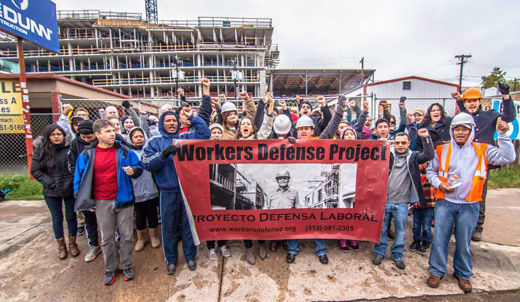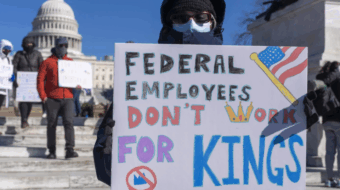
HOUSTON – Labor unions, including some that did not at first like the idea, say that hooking up with nonunion workers’ centers has helped them make gains, including growing their own memberships.
The push for unions to reach out to workers’ centers and other allied organizations was given a formal endorsement at last September’s convention of the AFL-CIO, held in Los Angeles. The new approach was considered a do-or-die matter for both unionized and nonunionized workers, all of whom have been under attack by the right wing in this country for many years.
The effects of the decision to move in a new direction were evident here this week at the annual winter meeting of the federation’s executive council. In a room that would, in the past, have been reserved for union presidents, leaders in the fight for social justice, both union and nonunion, were sitting around the same table.
“I wasn’t convinced at first,” said Mike Cunningham, president of the Texas Building Trades. “I used to see construction workers on nonunion sites as a threat to our jobs but it started to change when I saw some of the things being done by the Texas Workers Defense Project.” The Texas Workers Defense Project is a group of largely immigrant workers fighting for their rights on construction and other projects in Austin.
“There was a protest at a construction site and I walked by 141 pairs of empty construction boots lined up on the sidewalk, each pair representing a nonunion worker who had died on a construction site in Texas. These men and women are us,” I said to myself. “These are my brothers and sisters. We owe them a commitment to work together.”
Cunningham then described how the building-trades unions, the Texas Workers Defense Project and other workers’ centers got together and marched on the state legislature in Austin to demand an end to wage theft and to demand stronger safety laws.
“It was a big demonstration, people marching together, carrying 141 coffins, one for each worker killed,” he said.
“I’m proud to say our unity resulted in a victory,” Cunningham added. The legislature passed a law fining any contractor who wrongly classified a worker as a contractor in order to pay that worker a lower wage than would otherwise be required. “It was a big victory under our belt and we’re not done with this working together by any means,” said Cunningham.
Greg Casar, political director of the Texas Workers Defense Project, described how his group’s collaboration with the building trades unions has resulted in what may seem like small victories to many but are of enormous importance to workers.
“We didn’t even have the right to take breaks to drink water as we worked in the hot sun,” he said. “Now we do. Imagine, a contractor who gets big tax breaks from Texas denying workers even their most basic human right to a drink of water.”
Casar said association with the organized labor movement has also brought workers improved health and safety conditions and regularized training. “And we all share in that victory on the fines for employers who steal our wages,” he said.
There are some 600,000 people employed in the construction industry in Texas, about half of whom are undocumented immigrants.
James Hasalam, director of the Vermont Workers Center, was also among the participants at the AFL-CIO executive council deliberations here. The Vermont center started as a group of low-wage workers who established a workers rights hotline in 1998. In 2001, they hooked up with Jobs with Justice and they began a “healthcare is a human right” campaign to push for free universal healthcare in Vermont. In 2011 they began a partnership with the American Federation of State County and Municipal Employees to push for their healthcare initiative and to unionize healthcare workers.
“Since then we have gotten 7,000 new AFSCME members in Vermont,” said AFSCME President Lee Saunders. We could not have done this without our partnership with the Vermont Workers Center.”
Also among those on the floor at the executive council session here was Richard Shaw, secretary- treasurer of the Houston Central Labor Council, who said his group has developed a partnership with Houston’s Faith and Justice Workers Center. Laura Boston, that group’s director, also at he AFL-CIO meeting, said, “We have 700 members-workers who first came to us because they had suffered one or another form of wage theft.”
Joint rallies held by her group and the Central Labor Council resulted in passage of a wage theft ordinance here in Houston, whereby the city will not hire and will fire any contractor found to have stolen wages from his or her employees. “This was a big boost to us,” said Shaw, “because our unions have been going after these unscrupulous contractors for a long time.”
AFL-CIO president Richard Trumka said it was only natural that alliances between unions and workers centers would succeed.
“It’s simply people who represent and fight for workers’ rights taking care of one another. Brothers and sisters just do that,” he said.
Photo: Protest in front of site where a worker was fired for reporting a safety violation. Texas Workers Defense Project Facebook page.









